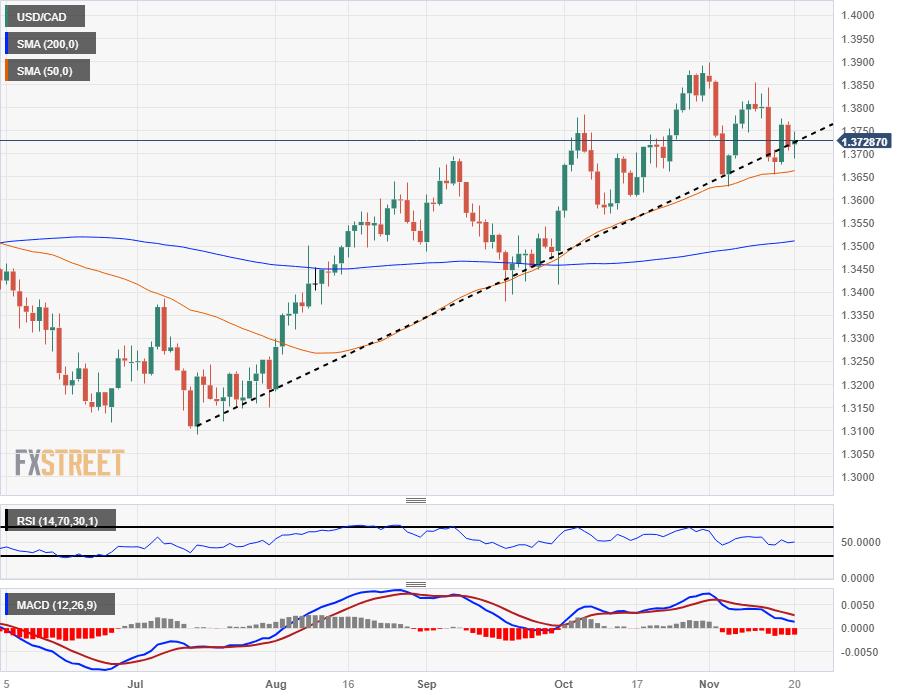- The Canadian dollar is trading stable as markets digest a quiet Monday.
- CPI inflation in Canada will be released on Tuesday, followed by retail sales at the end of the week.
- On the other hand, crude oil continues to rise, which benefits the CAD.
The Canadian Dollar (CAD) tilts lower in quiet trading on Monday as markets roil on Dollar (USD) Bets, but CAD losses appear limited by rising crude oil supplies.
The Canadian Consumer Price Index (CPI) will be released on Tuesday and Canadian Retail Sales will be released on Friday. The Minutes of the latest meeting of the Federal Open Market Committee (FOMC) of the Federal Reserve (Fed) will also be published on Tuesday.
Daily summary of market movements: The Canadian dollar rises gently after a calm but slightly optimistic Monday
- Tuesday’s Canadian CPI numbers will focus the attention of Loonie traders.
- Markets expect a slight rebound in the month-on-month figure, 0.1% for October compared to -0.1% in September.
- Annualized Canadian CPI inflation is expected to cool slightly to 3.6% from 3.8% previously.
- With markets focused on the dollar, the release of Tuesday’s Fed meeting minutes could take center stage.
- Markets are betting that the Fed has ended rate hikes, investors will focus on inflation numbers in anticipation of future rate cuts.
- Crude oil markets drift higher on Monday, but open interest is declining, which could see support for the CAD decline.
Technical Analysis: Canadian Dollar Seeks Support Point in Soft Monday Trading
The Canadian Dollar (CAD) is being pushed lower for the Monday session, leaning towards 1.3750 while the USD/CAD pair recovers at the 50-hour SMA. The pair hit an intraday low near 1.3690 early in the session, but USD/CAD is paring Friday’s declines from the 200-hour SMA at 1.3760.
On daily candles, USD/CAD continues to see bids putting pressure on dynamic technical support at the ascending trend line from July lows at 1.3100. Bids continue to find support at the 50-day SMA, and the long-term trend appears to support continued USD strength.
On the bearish side, USD/CAD is struggling to establish significant gains, and downside risks are increasing as the pair trades at year-long highs.
Current rate of the Canadian dollar
Below is the percentage change of the Canadian Dollar (CAD) against the currencies listed today. The Canadian dollar was the strongest currency against the US dollar.
| USD | EUR | GBP | CAD | AUD | JPY | NZD | CHF | |
| USD | -0.33% | -0.34% | 0.11% | -0.54% | -1.04% | -0.39% | -0.21% | |
| EUR | 0.33% | -0.02% | 0.44% | -0.20% | -0.70% | -0.05% | 0.14% | |
| GBP | 0.34% | 0.02% | 0.46% | -0.19% | -0.69% | -0.04% | 0.15% | |
| CAD | -0.12% | -0.44% | -0.47% | -0.66% | -1.16% | -0.50% | -0.32% | |
| AUD | 0.53% | 0.21% | 0.19% | 0.65% | -0.50% | 0.15% | 0.33% | |
| JPY | 1.03% | 0.71% | 0.45% | 1.14% | 0.50% | 0.65% | 0.82% | |
| NZD | 0.39% | 0.06% | 0.05% | 0.50% | -0.15% | -0.65% | 0.18% | |
| CHF | 0.20% | -0.12% | -0.14% | 0.32% | -0.34% | -0.84% | -0.19% |
The map shows the percentage changes of the major currencies against each other. The base currency is chosen in the left column, while the quote currency is chosen in the top row. For example, if you choose the euro in the left column and move along the horizontal line to the Japanese yen, the percentage change in the box will represent EUR(base)/JPY(quote).
USD/CAD Hourly Chart

USD/CAD Daily Chart

Frequently Asked Questions about the Canadian Dollar
What factors determine the price of the Canadian dollar?
The key factors driving the Canadian Dollar (CAD) are the level of interest rates set by the Bank of Canada (BoC), the price of oil, Canada’s largest export, the health of its economy, inflation and trade balance, which is the difference between the value of Canada’s exports versus its imports. Other factors are market sentiment, that is, whether investors are betting on riskier assets (risk appetite) or looking for safe havens (risk aversion), with risk appetite being positive for the CAD. As a major trading partner, the health of the US economy is also a key factor influencing the Canadian dollar.
How do the decisions of the Bank of Canada influence the Canadian dollar?
The Bank of Canada (BoC) significantly influences the Canadian dollar by setting the level of interest rates that banks can lend to each other. This influences the level of interest rates for everyone. The BOC’s main objective is to keep inflation between 1% and 3% by adjusting interest rates up or down. Relatively higher interest rates are usually positive for the CAD. The Bank of Canada can also use quantitative easing and tightening to influence credit conditions, with the first being negative for the CAD and the second being positive for the CAD.
How does the price of oil influence the Canadian dollar?
The price of oil is a key factor influencing the value of the Canadian Dollar. Oil is Canada’s largest export, so the price of oil tends to have an immediate impact on the value of the CAD. Generally, if the price of oil rises, the CAD also rises, as aggregate demand for the currency increases. The opposite occurs if the price of oil falls. Higher oil prices also tend to result in a higher probability of a positive Balance of Trade, which is also support for the CAD.
How does inflation data influence the value of the Canadian Dollar?
Although inflation has traditionally always been considered a negative factor for a currency, as it reduces the value of money, the opposite has actually happened in modern times with the relaxation of cross-border capital controls. Inflation tends to lead central banks to raise interest rates, which attracts more capital from international investors looking for a lucrative place to store their money. This increases the demand for the local currency, which in the case of Canada is the Canadian Dollar.
How does economic data influence the value of the Canadian dollar?
Macroeconomic data releases measure the health of the economy and can influence the Canadian dollar. Indicators such as GDP, manufacturing and services PMIs, employment and consumer sentiment surveys can influence the direction of the CAD. A strong economy is good for the Canadian dollar. Not only does it attract more foreign investment, but it may encourage the Bank of Canada to raise interest rates, resulting in a stronger currency. However, if economic data is weak, the CAD is likely to fall.
Source: Fx Street
I am Joshua Winder, a senior-level journalist and editor at World Stock Market. I specialize in covering news related to the stock market and economic trends. With more than 8 years of experience in this field, I have become an expert in financial reporting.







